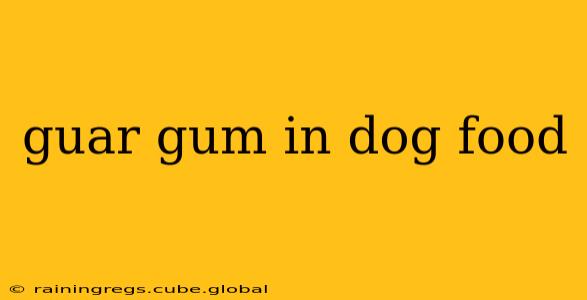Guar gum, a natural, plant-based polysaccharide derived from the guar bean, is increasingly appearing as an ingredient in commercial dog food. Its inclusion sparks curiosity and sometimes concern among pet owners. This comprehensive guide will delve into the role of guar gum in dog food, addressing common questions and concerns.
What is Guar Gum?
Guar gum is a soluble fiber extracted from the endosperm of the guar bean ( Cyamopsis tetragonolobus). It's a complex carbohydrate composed primarily of galactose and mannose, forming a viscous solution when mixed with water. This thickening property is its primary function in many food products, including dog food.
Why is Guar Gum in Dog Food?
Guar gum's presence in dog food is primarily due to its functional properties:
- Thickening and Binding Agent: It helps bind ingredients together, creating a more uniform and palatable kibble texture. This is particularly useful in creating a desirable texture for dry dog food.
- Improved Stability: Guar gum can enhance the shelf life of dog food by stabilizing the product and preventing separation of ingredients.
- Enhanced Palatability: The slightly viscous texture can contribute to a more appealing mouthfeel for dogs.
- Fiber Source: Though not a primary source of fiber, guar gum contributes to the overall fiber content, potentially aiding digestion in some dogs.
Is Guar Gum Safe for Dogs?
The general consensus among veterinary experts is that guar gum is safe for dogs in moderate amounts. It's considered a generally recognized as safe (GRAS) substance by the Food and Drug Administration (FDA) for human consumption and is widely used in pet food without significant adverse effects reported. However, as with any ingredient, individual sensitivities can exist.
Can Guar Gum Cause Digestive Issues?
While generally safe, large quantities of guar gum can lead to digestive upset in some dogs. This is because of its high fiber content. Symptoms may include:
- Gas: Increased flatulence
- Bloating: Abdominal distension
- Diarrhea: Loose or watery stools
- Constipation: In rare cases
These issues are more likely to occur if a dog consumes excessive amounts of guar gum, either through a diet heavily reliant on guar gum-rich foods or through accidental ingestion of large quantities of the pure substance.
What are the Alternatives to Guar Gum in Dog Food?
Several other ingredients serve similar functions in dog food:
- Other Gums: Xanthan gum, locust bean gum, and carrageenan are examples of other thickening and binding agents.
- Starches: Corn starch, potato starch, and tapioca starch can contribute to texture and binding.
- Fibrous Vegetables: Ingredients like carrots, peas, and sweet potatoes provide natural fiber and binding properties.
The specific alternative used varies depending on the manufacturer's formulation and desired product characteristics.
How Much Guar Gum is in Dog Food?
The amount of guar gum in dog food is typically low and varies depending on the brand and specific recipe. It's usually listed on the ingredient label, although the exact percentage might not be disclosed. If you have concerns, contacting the manufacturer directly may provide more specific information.
Does Guar Gum Affect a Dog's Coat or Skin?
There is no evidence to suggest that guar gum directly affects a dog's coat or skin. Any observed changes in coat or skin condition are more likely related to other dietary factors or underlying health issues.
This information is for educational purposes only and should not be considered veterinary advice. Always consult with your veterinarian if you have concerns about your dog's diet or health. They can assess your individual dog's needs and recommend the best course of action.
